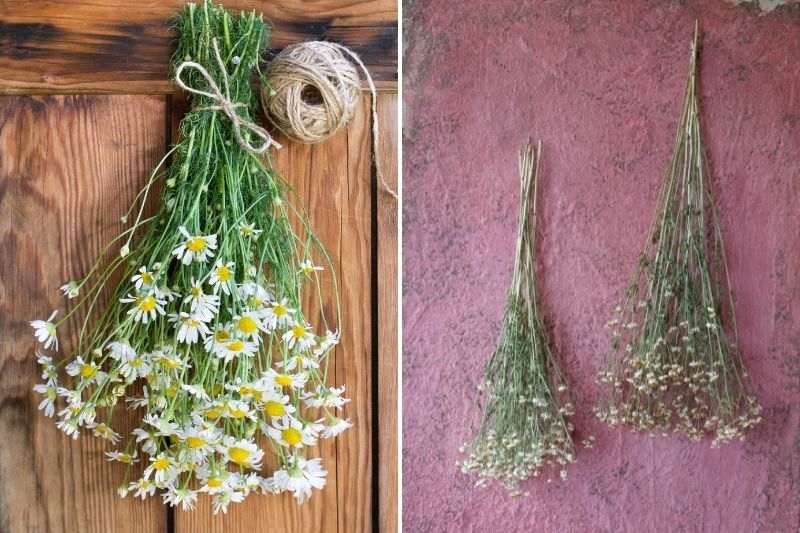For some, chamomile evokes a bitter herbal tea (some refer to it as chamomile tea), but it is far more interesting than it seems and renowned for its numerous benefits. To begin with, it’s important to note that there isn’t just one single type of chamomile. There are, in fact, three medicinal plants bearing the name chamomile. They belong to different botanical genera, although all three are part of the large Asteraceae family.
We have:
- Roman Chamomile, Chamaemelum nobile, perhaps the most well-known and the first that comes to mind;
- German Chamomile, Matricaria recutita, also called Wild Chamomile or Scented Mayweed;
- Feverfew, Tanacetum parthenium (or Chrysanthemum parthenium), also known as Bachelor’s Buttons.
These three plants have distinct properties, although those of the first two are relatively similar. Therefore, it’s essential to determine which chamomile you’re looking for before identifying the plant you wish to use. Additionally, the harvesting and drying of the flowers primarily concern the first two: Roman Chamomile and German Chamomile. In the case of Feverfew, it’s mainly the leaves that are used.

Chamaemelum nobile (photo Mélanie Show), Matricaria recutita and Tanacetum parthenium
When to Harvest Chamomile Flowers?
Chamomiles bloom for several months, typically from May to September. The flowers should be harvested when they have just bloomed and are fully open.
You can make multiple harvests, as picking them gradually during the flowering period will allow the plant to replenish its reserves.
As always, for harvesting, choose a day without rain to facilitate drying and avoid mould development, and a sunny day to maximise the active compounds.
Some may also advise picking the flowers preferably in the morning, after the dew has evaporated, to preserve their aroma.

How to Harvest and Dry Chamomile Flowers?
There are two drying techniques, one applicable to all three chamomiles, the other more suited to Feverfew. In both cases, drying chamomile takes about a week.
- Either you pick the flowers one by one and dry them flat on a cloth or tray, in a cool, dry place away from light;
- Or you make bouquets of fully open flowers—which is quite easy with Feverfew—and hang them upside down, away from light, which will undoubtedly add a rustic touch to your home. Once they are thoroughly dry, you can simply detach the flowers.
You can also dry them in a dehydrator. To do this, spread the flowers in a single layer on the tray and let them dry for 1 to 4 hours, checking every 30 minutes. In the oven, at the lowest temperature, drying will take a few hours, depending on the oven, with regular checks. Finally, chamomile can be dried in the microwave. Place the flowers between two sheets of absorbent paper and dry for 30 seconds to 2 minutes, depending on the power. Check every 30 seconds until completely dry.
Dried flowers take on a slight ivory hue. If they turn brown, discard them.

Drying flowers in hanging bouquets
How to Store Chamomile Flowers?
Once the flowers are thoroughly dry—meaning they crumble between your fingers—you can store the chamomile in an airtight container, well protected from moisture.
Stored this way, chamomile flowers can last for several months. Remember to label your containers, especially if you’re drying flowers from different chamomile varieties. Otherwise, you might struggle to tell them apart in the future.
Uses of Chamomile Flowers
To extract the active compounds from chamomile, as with most flowers, the infusion method is used, which involves pouring boiling water over the dried plant.
Generally, use one teaspoon of dried chamomile heads (Roman or German Chamomile) per cup. Or dried leaves for Feverfew.
However, be cautious: people allergic to Asteraceae should take precautions, as a reaction is not impossible. Interactions with certain medications are also possible, so don’t hesitate to consult a professional.

Indications
Roman Chamomile & German Chamomile
Let’s start with the properties of Roman Chamomile (or Noble Chamomile) and German Chamomile (or Matricaria), which are relatively similar.
Both can be taken orally or applied topically to the skin.
Oral Use
As a herbal tea, chamomile is commonly used to soothe digestive discomfort. It may help alleviate bloating, flatulence, belching, and other digestive issues.
German Chamomile might also stimulate appetite.
Topical Use
Roman and German Chamomile have soothing and antipruritic properties on the skin, meaning they can help calm itching. They may also aid in healing scrapes, chapped skin, cracks, and insect bites.
Irritated eyes can also benefit from the calming properties of these two chamomiles.
Be careful, though: for this use, you’ll need to be particularly meticulous during preparation to ensure a safe lotion.
While it’s customary to steep the flowers, here it’s better to boil them for one to two minutes. Then turn off the heat and let them steep before straining thoroughly to remove all particles. Wait for the liquid to cool completely—you wouldn’t want to burn your eyes!—before soaking a cotton pad or soft, clean cloth and placing it gently on your eyelids.
Finally, note that Matricaria (or German Chamomile) is reputed to lighten hair and is even an ingredient in shampoos designed for this purpose.
Feverfew
The properties of this plant are quite different from those we’ve just discussed.
Here, it’s not the flowers that are used but the aerial parts—primarily the leaves.
Feverfew infusions may relieve migraines and other headaches. They might also be used for painful periods.
In Conclusion
Always be extremely cautious when using plants. If you’re seeking to use plants for therapeutic purposes, it’s highly advisable to consult a specialist.
Moreover, and this is particularly true for chamomiles due to the confusing common names, it’s crucial to be rigorous about plant identification and refer to the Latin names.































![[dry_flowers plant="chamomile"]](https://en.promessedefleurs.eu/blogwp/wp-content/uploads/2021/07/Faire-secher-fleurs-camomille.jpg)
Comments